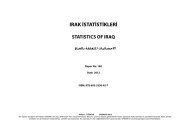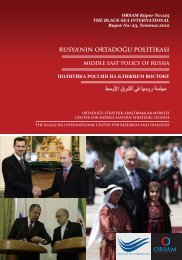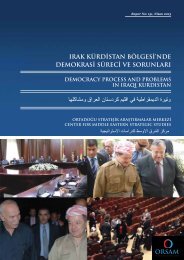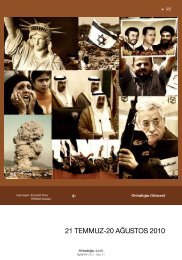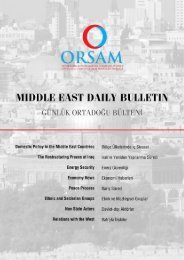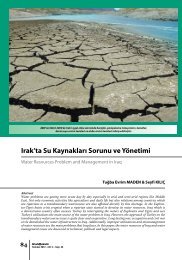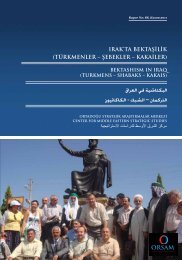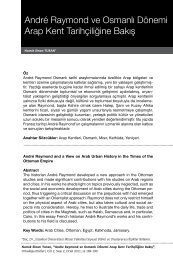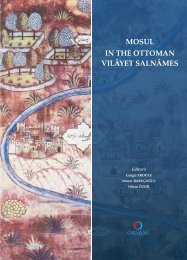Full text - orsam
Full text - orsam
Full text - orsam
You also want an ePaper? Increase the reach of your titles
YUMPU automatically turns print PDFs into web optimized ePapers that Google loves.
ORSAM<br />
CENTER FOR MIDDLE EASTERN STRATEGIC STUDIES<br />
Introduction<br />
The administrative experience of Iraqi Kurdistan<br />
started as a result of the fact that the<br />
people in the region no longer wanted to live<br />
under the rule of former Iraqi regime following<br />
the popular uprising that took place on<br />
March 1991. In the past, the people did not<br />
ask for such a thing. Because the aforesaid<br />
regimes had committed horrible murders<br />
against these people by encroaching their<br />
political, national and humanitarian rights in<br />
an environment of deprivation and tyranny.<br />
Such that, these murders had almost reached<br />
genocide level in the Halabja and Anfal operation.<br />
Therefore, the people in KRG surged<br />
into neighboring countries on late March and<br />
early April 1991, after the Iraqi troops returned<br />
to Kurdish regions. As a result of this, the<br />
international community intervened and decided<br />
to form safe zones in northern Iraq for<br />
Kurds. After the Iraqi regime took a decision<br />
for all political, military and civilian state institutions<br />
and organizations to withdraw from<br />
Sulaymaniya, Erbil and Duhok on October<br />
1991, “de facto” administrations emerged in<br />
the areas where Kurds seized control. Those<br />
steps encouraged Kurdish political parties to<br />
fill the authority gap and establish a democratic<br />
political regime based on the votes of<br />
electors in the areas under their own control.<br />
The first democratic election was held on<br />
May 1992 to elect the leader of National Assembly<br />
and Kurdish liberation movement for<br />
the administration of the areas where Kurds<br />
seize control. As a result of this election, the<br />
government was established and civilian and<br />
judicial institutions and organizations started<br />
to be created in the region. However, the civil<br />
war and conflicts between the two major<br />
parties; Kurdistan Democratic Party (KDP)<br />
and Patriotic Union of Kurdistan (PUK) prevented<br />
further development of this young democratic<br />
experience. As a result, autonomous<br />
Iraqi Kurdistan was divided into two parts,<br />
each controlled by different political parties.<br />
At this point, analyzing the problems before<br />
the democratic process besides the political<br />
system in Iraqi Kurdistan, and solution to be<br />
offered to these problems becomes important.<br />
The Reason of the Research<br />
This research strives to shed light on the political<br />
system that emerged as a result of the<br />
transition that took place in early 1990s, set<br />
of this system in the following process, and<br />
the factors that ruined the democratic view<br />
here. To that end, a series of questions will be<br />
strived to be answered. Some of these questions<br />
might be listed as follows: What is the<br />
administrative structure of Iraqi Kurdistan? Is<br />
this a parliamentary system, or a presidential<br />
system? How does it affect the democratic<br />
process in the region? What is the impact of<br />
the relations among political parties, especially<br />
the relations between KDP and PUK<br />
which are two parties in power, on administrative<br />
institutions and organizations in the<br />
region? What are the most important reflections<br />
and setbacks of the democratic system<br />
in the region?<br />
Hypothesis of the Research<br />
Besides these main problems, some secondary<br />
questions will be strived to be answered<br />
through hypothesis: “The democratic process<br />
under the influence of relations between the<br />
two political parties in power within KRG<br />
is faced with a series of problems, and these<br />
problems lead to eviscerating the real content<br />
that would provide the public interest”.<br />
Research Method<br />
Descriptive method will be used to prove the<br />
main hypothesis of the research and to explain<br />
the most important characteristics of the<br />
8<br />
ORSAM<br />
Report No: 151, April 2013




